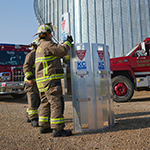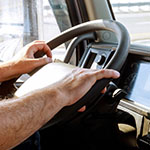Reduce liability risk in retail areas
Follow these recommendations to help prevent liability losses.
There are a variety of liability issues that convenience, grocery and farm store retailers face on a daily basis. These include injuries caused by store displays or improperly stacked goods, slip and falls, parking lot safety concerns and the presence of hazardous substances in the store.
Retailers have a duty of reasonable care to keep their retail areas in a reasonably safe condition for customers. Retailers can ensure they’re exercising reasonable care by taking appropriate risk management measures. For retailers that lease space to others, they can protect themselves by requiring indemnity provisions in the leasing contract and obtaining additional insured status on the lessee’s insurance policy.
Displays or improperly stacked merchandise
Store displays and stacked merchandise create liability concerns for retailers through faulty design (such as display racks with hard-to-see, protruding lower shelves), poor placement and a possibility of toppling on customers. Retailers can take several precautions to ensure they don’t incur expenses as a result of store displays or improperly stacked merchandise.
Risk management recommendations:
- Establish written procedures and employee training for stocking shelves and preparing displays.
- Conduct periodic inspections of displays and shelves for hazards.
- Post signs stating that customers are to request employee assistance for items on tall shelves.
- Clearly mark lower-level shelves that protrude into aisle ways.
- Use contractual indemnity provisions for any shelving/displays obtained from other companies.
Slips and falls
Liability for slips and falls can occur as a result of untreated weather conditions, poor cleaning techniques or schedules and slippery flooring materials. Slips and falls can occur in almost every location, but these accidents can be prevented with simple changes or adjustments.
Risk management recommendations:
- Establish written housekeeping procedures to keep all areas clean and orderly. Maintain a housekeeping log.
- Conduct periodic inspection of the premises for falling hazards. Maintain records of inspection.
- Require employee training in matters of safety procedures, cleaning operations and inspection procedures. Maintain a record of training.
- Use mats at doorways to the exterior and all other locations where slippery conditions are foreseeable.
- Use posted caution signs or barriers to warn and/or prevent access to any hazards.
Parking lot safety
Retailers should be aware of the liability concerns that arise in the exterior areas of their stores, including parking lots, sidewalks and crosswalks. Liability can be incurred in these exterior spaces as a result of weather conditions (either not handled or improperly handled), improperly maintained surfaces, lack of or inadequate signs, safety mirrors, and pavement markers or shopping carts. There are several steps retailers can take to minimize losses due to parking lot safety.
Risk management recommendations:
- Establish procedures for the prompt removal of snow, ice and other environmental concerns. Include procedures for the application of salt or sand when applicable.
- Use clearly marked signage, pavement painting and safety mirrors.
- Provide clearly marked bike parking.
- Establish procedures for the containment and collection of shopping carts.
- Periodicly inspect parking lots for hazards.
- Where a contractor is used, require indemnity provisions in the contract and additional insured status on contractor's policy.
Hazardous substances
Hazardous substances are liability mine fields, in terms of transporting, storing and cleaning up after spills. There are many federal regulations related to hazardous substances which give guidance on proper transportation, storage, labeling, cleanup and emergency procedures. Retailers should be aware of any regulations surrounding the presence of chemicals on their property and should be sure to put appropriate measures in place to ensure compliance.
Risk management recommendations:
- Keep up on current hazardous materials regulations issued.
- Develop and review operations and policy manuals.
- Properly classify and label hazardous products.
- Schedule appropriate employee training about safety procedures, storage, handling and other hazards.
- Develop emergency action plans.
- For self-service gas stations:
- Provide adequate distance between gas pumps and customer parking spots.
- Provide adequate guards or barriers around gas pumps.
- Locate pumps a safe distance from entrances and exits.
Please note that the recommendations contained in this article are not a complete list. For more information on risk management techniques, please refer to your Nationwide Agribusiness risk management consultant.

 >
>

 >
>
 >
>